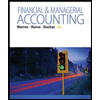
Concept Introduction:
Journal entries:
The business runs with the transactions it makes. Every transaction results in some outcome like the creation of an asset, liability, income, loss, gain, or expense. The transactions are recorded based on the resulting outcome. The debits and the credits are made based on the rules of accounting.
To prepare: December 31 year-end adjusting entry for estimated future sales returns and allowances (revenue side).
Concept Introduction:
Journal entries:
The business runs with the transactions it makes. Every transaction results in some outcome like the creation of an asset, liability, income, loss, gain, or expense. The transactions are recorded based on the resulting outcome. The debits and the credits are made based on the rules of accounting.
Adjusting entries: Adjusting entries are prepared to complete the financial statement of the company and to reflect the accrual method of accounting. Adjusting entries are prepared before the issuance of the financial statement.
To prepare: December 31 year-end adjusting entry for estimated future inventory returns and allowances (cost side).
Concept Introduction:
Journal entries:
The business runs with the transactions it makes. Every transaction results in some outcome like the creation of an asset, liability, income, loss, gain, or expense. The transactions are recorded based on the resulting outcome. The debits and the credits are made based on the rules of accounting.
Adjusting entries: Adjusting entries are prepared to complete the financial statement of the company and to reflect the accrual method of accounting. Adjusting entries are prepared before the issuance of the financial statement.
To prepare: Journal entry to record merchandise returned on January 3
Want to see the full answer?
Check out a sample textbook solution
Chapter 5 Solutions
FUND.ACCT.PRIN.-CONNECT ACCESS
- Provide correct answer general accounting questionarrow_forwardAn internal auditor's work would most likely affect the nature, timing, and extent of an independent CPA's auditing procedures when the internal auditor's work relates to assertions about the:a. Existence of contingencies.b. Valuation of intangible assets.c. Estimated salvage values of fixed assets.d. Valuation of related party transactions.e. Completeness of accounts payable. is it a or e?arrow_forwardCorrect answer needarrow_forward
- Please give correct answer this financial accounting questionarrow_forwardThe Caldwell Division's operating data for the year 2019 is as follows: • Return on investment = 14% • • • Minimum required rate of return = 11% Average net operating assets = $620,000 Sales $2,100,000 = Compute the margin for 2019.arrow_forwardFinancial accountingarrow_forward
- Principles of Accounting Volume 1AccountingISBN:9781947172685Author:OpenStaxPublisher:OpenStax College
 Intermediate Accounting: Reporting And AnalysisAccountingISBN:9781337788281Author:James M. Wahlen, Jefferson P. Jones, Donald PagachPublisher:Cengage Learning
Intermediate Accounting: Reporting And AnalysisAccountingISBN:9781337788281Author:James M. Wahlen, Jefferson P. Jones, Donald PagachPublisher:Cengage Learning Cornerstones of Financial AccountingAccountingISBN:9781337690881Author:Jay Rich, Jeff JonesPublisher:Cengage Learning
Cornerstones of Financial AccountingAccountingISBN:9781337690881Author:Jay Rich, Jeff JonesPublisher:Cengage Learning - Principles of Accounting Volume 2AccountingISBN:9781947172609Author:OpenStaxPublisher:OpenStax College
 Intermediate Financial Management (MindTap Course...FinanceISBN:9781337395083Author:Eugene F. Brigham, Phillip R. DavesPublisher:Cengage Learning
Intermediate Financial Management (MindTap Course...FinanceISBN:9781337395083Author:Eugene F. Brigham, Phillip R. DavesPublisher:Cengage Learning Financial & Managerial AccountingAccountingISBN:9781285866307Author:Carl Warren, James M. Reeve, Jonathan DuchacPublisher:Cengage Learning
Financial & Managerial AccountingAccountingISBN:9781285866307Author:Carl Warren, James M. Reeve, Jonathan DuchacPublisher:Cengage Learning





